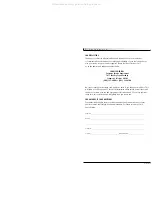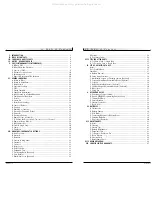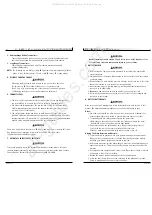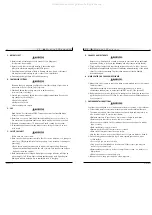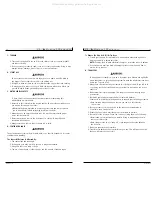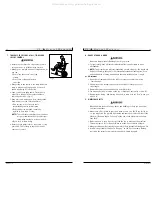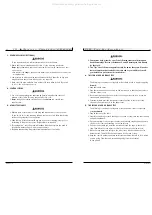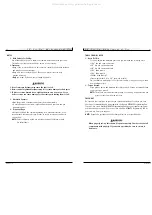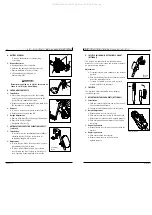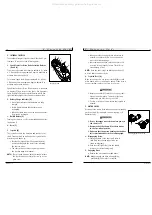
930482 Rev. A
V I . G e n e r a l W a r n i n g s
11
Heed all warnings in this section. If you fail to do so a fall, tip-over or loss
of control may occur and cause severe injury to your or others.
A. NOTICE TO RIDER
1. Before using this chair, you should be trained in its safe use by your health
care professional.
2. Every wheelchair is different. Take the time to learn the feel of this chair before
you begin riding.
3. Be aware that you must develop your own methods for the safe use of this chair
that are best suited to your level of function and ability.
4. Have someone help you practice bending, reaching and transferring until you
learn how to do them safely.
5.
Never
try a new maneuver on your own unless you are sure it is safe.
6. Get to know the areas where you plan to use your chair. Look for hazards and
learn how to avoid them.
B. NOTICE TO ATTENDANTS
Make sure you heed all warnings and follow all instructions in each section of this
manual. (Be aware that warnings that apply to the rider also apply to you).
Notes:
1. You need to work with the rider, and the rider’s doctor, nurse or therapist, to
develop safe methods best suited to your abilities and those of the rider.
2. To manually push the chair you must release the motor locks.
•Make sure you have full control over the chair when you release the motor
locks. When you do so the chair will not have brakes.
3. Propel this chair by the push handles only. They provide secure points for
you to hold the rear of the chair to prevent a fall or tip-over.
•Check to make sure push handle grips will not rotate or slip off.
Helping The Rider Overcome An Obstacle:
1. To prevent injury to your back, use good posture and proper body mechanics.
When you lift or support the rider or tilt the chair, bend your knees slightly
and keep your back as upright and straight as you can.
2. Before each maneuver, tell the rider what you plan to do, and explain what you
expect the rider to do. This will put the rider at ease and reduce the risk of an
accident.
3. Go straight up and straight down a curb or stair. If you turn or climb or descend
at an angle, a fall or tip-over is likely.
4. Remind the rider to lean back when you tilt the chair backward.
5. Lower the chair slowly. Do not let the chair drop to the pavement or ground.
Doing so may damage the chair or injure the rider.
V . E M I ( E l e c t r o m a g n e t i c I n t e r f e r e n c e )
930482 Rev. A
10
2. Medium-Range Mobile Transceivers:
These include two-way radios used in police cars, fire trucks, ambulances and
taxi cabs. The antenna is usually mounted on the outside of the vehicle.
3. Long-Range Transceivers:
These include commercial radio and TV broadcast antenna towers and
amateur (HAM) radios.
NOTE–
The following are not likely to cause EMI problems: Lap-top computers (without
phone or fax), Cordless phones, TV sets or AM/FM radios, CD or tape players.
D. DISTANCE FROM THE SOURCE
EM energy rapidly becomes more intense as you get closer to the source.
For this reason, EMI from hand-held devices is of special concern.
(See C.1 pg. 9) A person using one of these devices can bring high levels
of EM energy very close to your chair without you knowing it.
E. IMMUNITY LEVEL
1. The level of EM is measured in volts per meter (V/m). Every power wheelchair
can resist EMI up to a certain level. This is called its “immunity level”.
2. The higher the immunity level, the less the risk of EMI. It is believed that a
20 V/m immunity level will protect the power wheelchair user from the more
common sources of radio waves.
3. The configurations tested and found to be immune to at least 20 V/m are:
Quickie V-100 power wheelchair with a right hand mounted Penny & Giles Pilot
integral controller, 18” seat width, 17” seat depth, single post height adjustable
armrest, swing-away 60º hangers and 22NF gel cell batteries.
There is no way to know the effect on EMI if you add accessories or modify this chair.
Any change to your chair may increase the risk of EMI. Parts from other
suppliers have unknown EMI properties.
F. REPORT ALL SUSPECTED EMI INCIDENTS
You should promptly report any unintended movement or brake release. Be sure to
indicate whether there was a radio wave source near your chair at the time. Contact:
Sunrise Medical, Customer Service Department at (800) 333-4000.
All manuals and user guides at all-guides.com
all-guides.com


